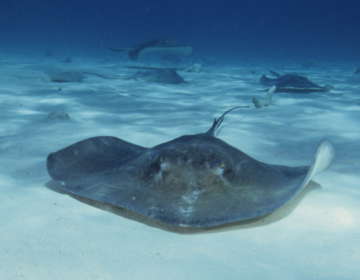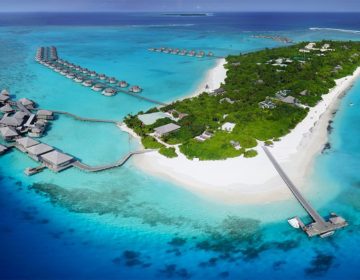Rakeedhoo Kandu
Rakeedhoo is one of five inhabited islands in the atoll and is the most southern island of the atoll. There are channels on either side of Rakeedhoo, but Rakeedhoo Kandu is the most popular channel for diving and is on the eastern side of the island. It is a deep channel with an entrance around 50 meters. On both sides of the channel, the corners are magnificent with coral caves and overhangs at different depths.
The corner on the Rakeedhoo side is better known for its terraces. The first step starts at around 20 meters, and steps descend to approximately 45 meters. Under each plateau or coral, steps are overhangs and caves covered in soft coral. At the deeper depths of terrace corner are big beautiful sea fans and black coral trees. Terrace corner is a good location for spotting all kinds of pelagics including a big school of big-eye trevally and sharks, even hammerhead sharks in the dim light of early morning. At shallower depths are turtles, Napoleons, and sweetlips.
 Big-Eye Trevally
Big-Eye Trevally
Diving Hints
When there is a strong incoming current, it splits on the eastern side of Rakeedhoo reef sending divers either into the channel or along the outside reef of Rakeedhoo. The better choice is to dive on the inside of the channel.
Vattaru Kandu – PROTECTED MARINE AREA
Vattaru is a small rounded atoll south of Felidhe Atoll about 45 minutes by dhoni from Rakeedhoo. There is only one kandu. It is on the south side near the small uninhabited island of Vattarurah. The island corner gives the best opportunity for an excellent dive. The corner drops steeply on the outside to about 45 meters, then slopes to a deep sandy bottom where there are big sea fans and occasionally leopard sharks.
 Leopard shark
Leopard shark
The entrance of the channel is around 32 meters. There are a few caves and overhangs near the entrance and many more on the outside of the reef. Near the corner, most caves occur near between 10 and 20 meters. Fish life here is prolific with tuna, barracuda, trevally, schools of fusilier and white-tip reef sharks. Also seen are turtles and manta rays. There are more beautiful caves from about 30 meters outside the channel entrance. All the caves are covered with soft coral and in many are black coral trees and sea fans.
Explore this Protected Marine Area on an unforgettable diving experience. Click here.
Diving Hints
For night divers, Vattaru Kandu is a brilliant location. With an incoming current, the island corner is the best place to start and then drift into the channel. Spread across the sandy bottom and on the reef slope are various shaped coral rocks which provide a sound refuge for sleeping Napoleon and parrotfish.
 Most caves occur near between 10 and 20 meters.
Most caves occur near between 10 and 20 meters.
Anbaraa
There is easy diving on the north side of Anbaraa with walls from five to 25 meters and a few small caves with plenty of fire coral. It is a good location for a leisurely afternoon dive.
Anbaraa Thila
This is a small thila five minutes to the east of Anbaraa with the top at two meters. It is so small; divers can swim around it a couple of times at different depths. There is little current here. On the top is plenty of hard coral and is excellent for snorkeling. White-tip reef sharks are found here.
There are some channels along the western side with good diving features. On the west point of Felidhe Atoll is Maafussaru Kandu. It is the channel between Fussaru Falhu and Maahiththan Faru. On the northern side of the channel is a fascinating, gently sloping reef with a shallow entrance at 20 meters.
To the north is Dhiggaluvashee Kuda Kandu, also known as Kudaboli Kandu. The outside reef is at 35 meters, and the southern corner has caves at about 25 meters. Near the entrance, a finger of reef extends into the channel attracting plenty of grey reef and white-tip reef sharks. There are two kandus in the north, Kunaavashi Kandu and Boamas Kandu. Both are suitable for experienced divers.

(Source: Dive Maldives: A Guide to the Maldives Archipelago. Tim Godfrey. Atoll Editions, 2015)



